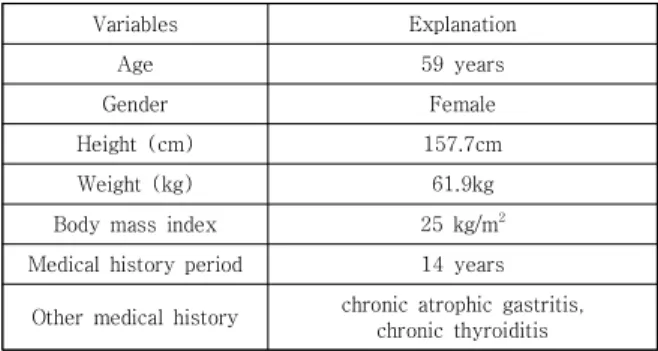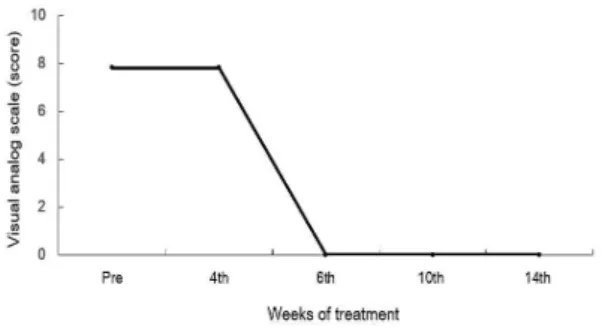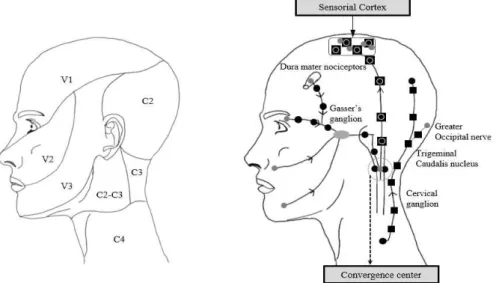Simultaneous Heat-Massage Therapy for Migraine Without Aura : A Case Report
Kwang-Jae Lee, Yong-Soon Yoon *
Department of Rehabilitation Medicine, Presbyterian (Jesus) Medical Center, Jeonju.
무전조성 편두통 환자에서 온열과 마사지 동시 치료의 효과: 증례보고
이광재, 윤용순 *
전주 예수병원 재활의학과
Abstract A migraine was a headache disorder characterized by recurrent moderate to severe headaches.
The diagnosis was based on clinical signs and symptoms. Medication, physical therapy, nerve block, and nerve stimulation could be applied for treatment. This report described a case of severe migraine without aura that lasted several weeks periodically in a 59-year-old woman. Periodic headache had lasted for more than 14 years, and although she took medicines and nerve blocks, severe pain (VAS 7) was persisted. We recommended her to use the thermo-spinal massage device (CGM MB-1401, CERAGEM Inc., Cheonan, South Korea) continuously three times a week applying in semi-automatic mode around the neck for 40 minutes. There was no change in the pain scale in the automatic mode for the first 4 weeks. Subsequently, the semi-automatic mode of the cervical area was treated for 2 weeks to relieve the pain scale, and it was confirmed that the relieved state maintained for 2 months.
This case highlighted the importance in considering thermo-spinal massage devices for managing migraine without aura.
Key Words : migraine without aura, superficial heat therapy, massage, headache, spinal-column, thermo-spinal massage
요 약 편두통은 중등도 내지 중증의 두통이 재발하는 것을 특징으로 하는 두통 장애이다. 진단은 임상 징후 및 증상을 기반으로 하며, 약물 치료, 물리 치료, 신경 차단 및 신경 자극이 치료에 적용될 수 있다. 이 보고서는 59세 여성의 심각한 무전조성 편두통 사례에 대한 것이다. 환자는 정기적으로 두통이 14년 이상 지속되었으며, 약과 신경 차단제를 복용했지만 심한 통증 (VAS 7)이 지속되어 왔다. 우리는 척주 온열 마사지 기기(CGM MB-1401)를 편두통 환자에게 6주간 주 3회씩 40분간 처치하였다. 최초 4주간의 자동모드에서는 통증척도에 변화가 없었다. 이후 경추부 반자동 모드를 2주간 처치하여 통증척도가 완화되었으며, 두 달 동안 통증이 없는 상태로 유지되었음을 확인하였다. 본 사례는 무전조성 편두통을 관리하기 위해 척주 온열 마사지기 적용을 고려할 수 있음을 강조한다.
주제어 : 무전조성 편두통, 표재열치료, 마사지, 두통, 척주, 온열 척추 마사지
*Corresponding Author : Yong-Soon Yoon(gvcdr@hanmail.net)
Received July 23, 2020 Revised August 4, 2020
Accepted August 20, 2020 Published August 28, 2020
1. Introduction
A migraine is a headache disorder characterized by recurrent periodic or non-periodic moderate to severe headaches [1]. A third of patients have an aura, a short period of visual disturbance, and several symptoms, such as nausea; vomiting; and sensitivity to light, sound, or smell, can be associated with it [2]. The mechanisms are unknown, but may be due to effects on the nerves and blood vessels of the brain [3].
The diagnosis is not simple and usually based on clinical signs and symptoms, so imaging studies are usually optional [3]. Pharmacological treatment, including analgesics, triptans, and ergotamines, is the typical first step; in refractory cases, physical therapy, nerve block, and nerve stimulation can be applied in conjunction with drugs.
Non-pharmacological treatments related to migraines include traditional massage treatments [4], acupuncture [5], relaxation therapy [6], and exercise therapy [7]. Among them, massage treatment has been proven effective as an alternative treatment for migraines [4,8,9].
Therefore, we recommended that heat and massage would be applied around the spinal- column to migraine patients who have been treated for migraine headaches for 14 years but who continuously complain of more than 7 in the Visual Analog Scale (VAS) assessment. After that, since the effects of pain improvement have been obtained, we would like to report the results through the comparison before and after.
2. Case Report
A 59-year-old woman complained of severe intermittent headache lasting for several weeks for 14 years from 2005. At first, she visited the Department of Neurology and was diagnosed with migraine without aura clinically with no abnormalities on imaging studies. She took
medicine (analgesics; including acepaminophen, NSIADs, selective norepinephrine reuptake inhobitor (SNRI), and tramadol; alprazolam; and flunarizine) and underwent 13 trigeminal, and greater and small occipital nerve blocks but pain rated 6–7 on the visual analog scale persisted.
She subsequently consulted neurology; pain clinic; ear, nose and throat; cardiology; and gastroenterology departments. She had no specific disease that related to migraine but had chronic atrophic gastritis and chronic thyroiditis.
Table 1 shows the individual characteristics of the migraine patients involved in this study.
Variables Explanation
Age 59 years
Gender Female
Height (cm) 157.7cm
Weight (kg) 61.9kg
Body mass index 25 kg/m
2Medical history period 14 years
Other medical history chronic atrophic gastritis, chronic thyroiditis
Table 1. Patient's personal characteristics
The pain scale used a reliable VAS, an analog scale of 10 cm. The left end of the VAS indicates 'no pain' and the right end indicates 'very severe pain' [10].
As she visited the Department of Rehabilitation Medicine for physical therapy, we recommended the use of a thermo-spinal massage device (CGM MB-1401, Ceragem, Cheonan-si, South Korea) three times a week continuously after conventional physical therapies, such as hot pack, therapeutic ultrasound, electrical stimulation, at the local clinic over a long period of time had no effect.
Figure 1 shows the changes in pain during the 6-week thermal massage and the change in pain scale for 2 months thereafter.
This device was applied in automatic mode for 40 minutes for 4 weeks from January 2020 and there was no symptomatic improvement;
therefore, we changed the application to
semi-automatic mode targeting only the cervical area in the same manner.
Fig. 1. Change of visual analog scale score according to treatment weeks
The symptom was relieved after 2 weeks of application around the neck. She maintained a pain-free state for two months. She has been dong well with minimal amount of acetaminophen intermittently and quite effectively (VAS 0-2) until the last visit in our clinic.
3. Discussion
Migraine is the most common neurological disorder and has a high prevalence worldwide [11].
Typical symptoms include unilateral throbbing headaches and hypersensitivity to visual, auditory, and sensory stimuli in one third of patients [12].
Unlike migraine with aura, migraine without aura is not related to an increased risk of other diseases such as ischemic stroke [13]; however, it causes a significant level of disability in everyday life.
Since migraine may appear in a nasty pattern, correct diagnosis is possible by incorporating trigger factors, prodromal symptoms, accompanying symptoms, response to treatment, and family history in addition to the diagnostic criteria. The diagnostic criteria of the international headache society diagnose headaches as the duration of the headache, the nature of the pain, and symptoms accompanying the headache. Premonitory symptoms and aura are the symptoms that
appear before a headache: Premonitory symptoms are symptoms that can predict headaches, such as fatigue, yawning, neck pain, several hours before the headache occurs and aura is a neural symptom such as a visual field defect before headache occurs. Although aura may vary in visual field defect, unilateral sensory deficit, and language problem, migraine with aura usually accompanies by visual symptoms.
In the onset of migraine headaches, overexcitation of the cortical neurons by central disinhibition and dysfunction of the brain stem play an important role and stimulation of the trigeminal nerve endings located in the blood vessels around the cortex or dura excites the trigeminal nerve, secreting neuropeptides, and causing neurogenic inflammation such as vasodilation and plasma protein exudation. The hypothalamus is also thought to play an important role in the pathophysiology of migraine headaches, as the symptoms of the precursors that occur before the onset of the headache originate from the hypothalamus. The headache is finally recognized by the afferent signal transmitted in the central direction through the trigeminal nucleus caudalis and thalamus to the cerebral cortex. In this series of processes, the strengthening of pain signals by central and peripheral sensitization and the weakening of the pain control function in the brain stem aggravate migraine pain.
In the case of this patient, the chronic headache
was controlled by continuously applying the
thermo-spinal massage device, which has been
reported to have various analgesic effects even
when there was no improvement following the
use of pain medication, physical therapy, and
injections for 6 weeks or more. As a result, a
headache-free condition was maintained. The
physiologic effects of massage are muscle
relaxation, improved blood and lymph
circulation, and neurohormonal immunologic
effects [14]. In addition, massage relaxes the
muscles and mind, and increases the pain threshold through the secretion of endorphins.
Massage around the neck is also described to have an inhibitory trigemino-cervical convergence mechanism (Fig. 2) that causes di ffuse nociceptive inhibition (Fig. 3) [15]. Diffuse nociceptive inhibitory control can be activated by stimuli that are not painful, such as neck massages, and the extent of its inhibitory control relies on the intensity of the stimuli. This is believed to be one of the mechanisms for the improvement of pain after selective treatment to the neck rather than whole spine massage in this case. Although it is not fully understood, Piovesan et al. [15] reported that it acts as an
inhibitory or stimulatory mechanism, causing diffuse nociceptive inhibitory control through the inhibitory mechanism and migraine, cervicogenic headache, or myofascial syndrome through the stimulatory mechanism. It is believed that the patient's pain is more effectively controlled due to increased metabolism, increased vasodilation, and increased blood flow, muscle stiffness, and analgesic effects, which are known to be effects of heat [16]. In conclusion, this present case highlights the importance in considering the thermo-spinal massage device for managing migraine without aura.
Fig. 3. Schematic diagram of diffuse noxious inhibitory controls. Inhibitory bulbospinal pathways: plus (+) indicates stimulation and minus (-) indicates inhibition.
Fig. 2. Convergence of cervical and trigeminal nociceptive systems. (A) Nociceptive
distribution of the trigeminal and cervical system and (B) schematic illustration
of convergence mechanisms during migraine attacks.
REFERENCES
[1] World Health Organization. (2016). Headache disorders-Fact sheet No 277.
https://www.who.int/en/news-room/fact-sheets/detail /headache-disorders.
[2] R. P. Simon, M. J. Aminoff, D. A. Greenberg (2009). Clinical neurology (7 ed.). New York : Lange Medical Books/McGraw-Hill. 85–88.
[3] J. Bartleson & F. M. Cutrer. (2010). Migraine update.
Minnesota medicine. 93(5), 36–41.
[4] Happe, S., Peikert, A., Siegert, R., & Evers, S. (2016).
The efficacy of lymphatic drainage and traditional massage in the prophylaxis of migraine: a randomized, controlled parallel group study.
Neurological Sciences, 37(10), 1627-1632.
DOI: 10.1007/s10072-016-2645-3
[5] Linde, K., Allais, G., Brinkhaus, B., Manheimer, E., Vickers, A., & White, A. R. (2009). Acupuncture for migraine prophylaxis. Cochrane Database of Systematic Reviews, (1). CD001218. .
DOI:10.1002/14651858.CD001218.pub2
[6] Penzien, D. B., Andrasik, F., Freidenberg, B. M., Houle, T. T., Lake III, A. E., Lipchik, G. L., ... & Nicholson, R.
A. (2005). Guidelines for trials of behavioral treatments for recurrent headache: American Headache Society Behavioral Clinical Trials Workgroup. Headache: The Journal of Head and Face Pain, 45, S110-S132.
[7] Narin, S. O., Pinar, L., Erbas, D., Oztürk, V., & Idiman, F. (2003). The effects of exercise and exercise-related changes in blood nitric oxide level on migraine headache. Clinical rehabilitation, 17(6), 624-630.
DOI: 10.1191/0269215503cr657oa.
[8] Lawler, S. P., & Cameron, L. D. (2006). A randomized, controlled trial of massage therapy as a treatment for migraine. Annals of Behavioral Medicine, 32(1), 50-59.DOI: 10.1207/s15324796abm3201_6
[9] Zanchin, G., Maggioni, F., Granella, F., Rossi, P., Falco, L., & Manzoni, G. C. (2001). Self-administered pain-relieving manoeuvres in primary headaches.
Cephalalgia, 21(7), 718-726.
[10] Scott, J., & Huskisson, E. C. (1979). Vertical or horizontal visual analogue scales. Ann Rheum Dis, 38(6), 560.
[11] R. Jensen & L. J. Stovner. (2008). Epidemiology and comorbidity of headache. The Lancet Neurology, 7(4), 354-361.
DOI : 10.1016/S1474-4422(08)70062-0
[12] T. J. Schwedt. (2013). Multisensory integration in migraine. Current opinion in neurology, 26(3), 248.
DOI : 10.1097/WCO.0b013e328360edb1
[13] T. Kurth et al. (2005). Migraine, headache, and the risk of stroke in women: a prospective study.
Neurology, 64(6), 1020-1026.
DOI : 10.1212/01.WNL.0000154528.21485.3A
[14] S. M. Fishman, J. C. Ballantyne, J. P. Rathmel. (2010).
Bonica’s Management of Pain 4th edition. Philadelphia : Lippincott Williams & Wilkins, 1365-1374.
[15] E. J. Piovesan et al. (2007). Massaging over the greater occipital nerve reduces the intensity of migraine attacks: evidence for inhibitory trigemino-cervical convergence mechanisms. Arquivos de neuro-psiquiatria, 65(3A), 599-604.
DOI : 10.1590/S0004-282X2007000400010
[16] T. R, Han et al. (2019). Rehabilitation Medicine 6th edition. Seoul : Kunja Publishing Co.
이 광 재(Kwang-Jae Lee) [정회원]
․ 1998년 2월 : 충남대학교 의학과(의학 사)
․ 2012년 2월 : 충남대학교 의학과( 의 학박사, 재활의학 전공)
․ 2011년 1월 ~ 현재 : 예수병원 재활의 학과 과장
․ 관심분야 : 신경근골격계 통증 및 초음 파, 뇌졸중 재활
․ E-Mail: rytt@naver.com
윤 용 순(Yong-Soon Yoon) [정회원]


